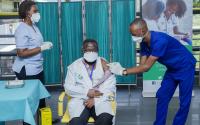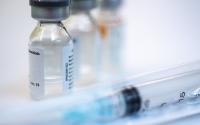[ad_1]
Table of Contents
Study shows breastmilk poses little risk of mom-to-baby COVID-19 transfer
A study today in mBio offers support to continue breastfeeding infants even when mothers have mild to moderate COVID-19 infections. The study showed breastmilk samples did not contain SARS-CoV-2 (the virus that causes COVID-19) RNA, but the authors suggest risk of transmission via breast skin to baby should be evaluated.
The study used multiple breastmilk samples (37) from 14 women following a positive COVID-19 test. None of the 37 samples had detectable SARS-CoV-2 RNA, but two of the infants tested positive for COVID-19. No illnesses were severe.
The authors conducted tests on skin swab samples taken from the mothers, which found evidence of viral RNA on 8 out of 70 breast skin swabs, with only one considered a conclusive positive result. The authors said more testing needs to be done to understand the risk of skin-to-skin transmission.
This is the first study to also demonstrate breastmilk produced by women with COVID-19 is able to neutralize SARS-CoV-2 infectivity, the authors said.
“In addition, 62% of the milk samples were able to neutralize SARS-CoV-2 infectivity in vitro, whereas milk samples collected prior to the COVID-19 pandemic were unable to do so,” the authors concluded. “Taken together with the well-documented benefits of breastfeeding to maternal and infant health, our data support recommendations to encourage breastfeeding in women with mild-to-moderate COVID-19 illness.”
Feb 9 mBio study
Dementia, COVID synergy associated with worse COVID outcomes
Not only are adults with dementia twice as likely to have COVID-19 infections, but those who get infected also experience higher mortality rates and increased COVID severity, according to an observational Alzheimer’s & Dementia study published today.
Racial disparities persist in this subpopulation, as well: The study reports that black people with dementia have increased odds for COVID infection, hospitalization, and mortality.
Using electronic health record data, the researchers winnowed down 61,916,260 possible people to 810 who had both COVID and dementia from February through August 2020 (5.1% of the COVID-infected subgroup). Patients with dementia were at increased risk for COVID-19 compared with patients without dementia (adjusted odds ratio [aOR], 2.00).
Vascular dementia had the highest COVID infection risk (aOR, 3.17), followed by presenile dementia (aOR, 2.62), Alzheimer’s disease (aOR, 1.86), senile dementia (aOR, 1.99), and post-traumatic dementia (aOR, 1.67). Because of the association between vascular dementia and COVID infection, the researchers suggest that brain pathology, particularly damaged endothelium tissues, may be a risk for SARS-CoV-2, the virus that causes COVID-19.
Overall, the 6-month mortality risk for adults with dementia and COVID-19 (21.0%) was higher than both the mortality rates for those with COVID but no dementia (4.8%) and those with dementia but no COVID infections (7.6%). Compared with white people with dementia, black people with dementia had greater hospitalization (73.1% vs 53.6%) and mortality rates (23.1% vs 19.2%). Black people with dementia were also 2.86 times more likely to have COVID infections once sex, age, and COVID-19 risk factors were adjusted for.
“COVID‐19 and dementia had a synergistic effect on 6‐month mortality risk as the risk was greater than the sum of their individual effects,” the researchers write. “We anticipate significant long‐term neurological effects of SARS‐CoV-2 infection in triggering or worsening dementia in survivors of COVID‐19 and expect higher prevalence of dementia in patients with COVID‐19 compared to the non‐infected population in the future.”
Maria Carillo, PhD, Alzheimer’s Association chief science officer, adds in a Case Western Reserve University press release, “It is critical we develop and implement strategies that strike a balance between keeping people, especially long-term care residents, safe from COVID-19 but also protecting them from health-related harms associated with social isolation.”
Feb 9 Alzheimer’s & Dementia study
Feb 9 Case Western press release
SARS-CoV-2 found to last longer on nonporous surfaces like glass, plastic
SARS-CoV-2 survives longer on nonporous surfaces like glass, plastic, and stainless steel as opposed to porous ones such as paper and cloth, reports a study published today by the American Institute of Physics’ (AIP’s) Physics of Fluids. While this helps confirm past studies on fomite surfaces, with this study, the researchers were able to provide a hypothesis as to why.
Researchers from the Indian Institute of Technology Bombay demonstrated that droplets of the virus can survive for 7 days on plastic or stainless steel, 4 days on glass, 2 days on cloth, and 3 hours on paper by using 1 microliter of pure water as a surrogate for SARS-CoV-2 droplets.
The droplet decay process is completed in two main parts, according to an AIP press release. First is the initial bulk evaporation, which decays 99.9% of the droplet in minutes. This is followed by the evaporation of the remaining thin liquid film where viral material can still survive. Porous materials speed up both parts by allowing absorption, not simply diffusion, to evaporate the initial bulk and then create disjoining pressures across the residual film because of its geometric fiber structure.
“The fact that just the geometric features rather than the chemical details of the porous material make the thin-film lifetime significantly less was surprising,” study author Rajneesh Bahrdwaj, PhD, said in the press release.
“Based on our study, we recommend that furniture in hospitals and offices, made of impermeable material, such as glass, stainless steel, or laminated wood, be covered with porous material, such as cloth, to reduce the risk of infection upon touch,” co-author Sanghamitro Chatterjee, PhD, MSc, added. The study itself goes on to suggest how these findings could be extrapolated to schools, warehouses and package sorting centers, clothes outlets, and more.
Feb 9 Phys Fluids study
Feb 9 AIP press release
[ad_2]
Source link












